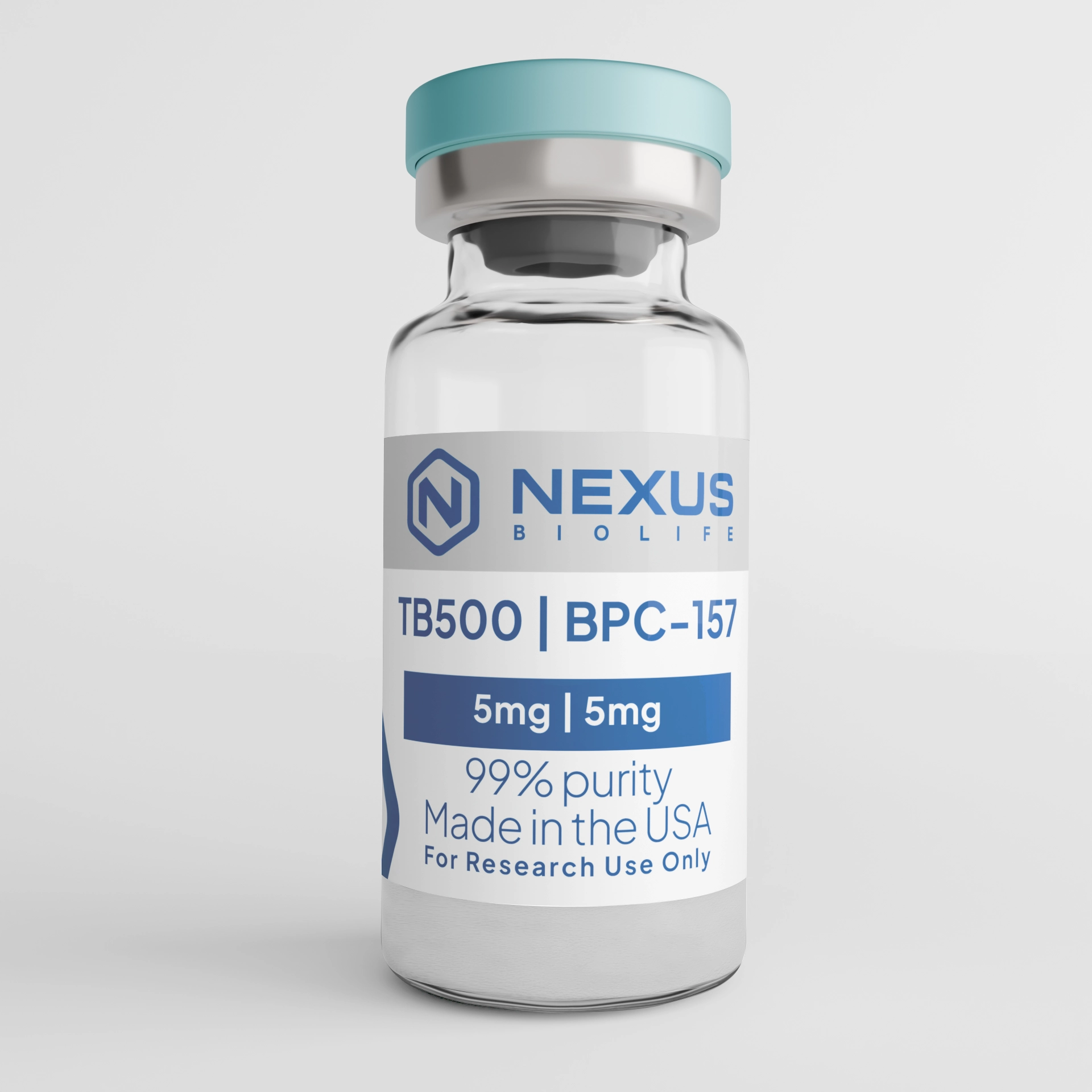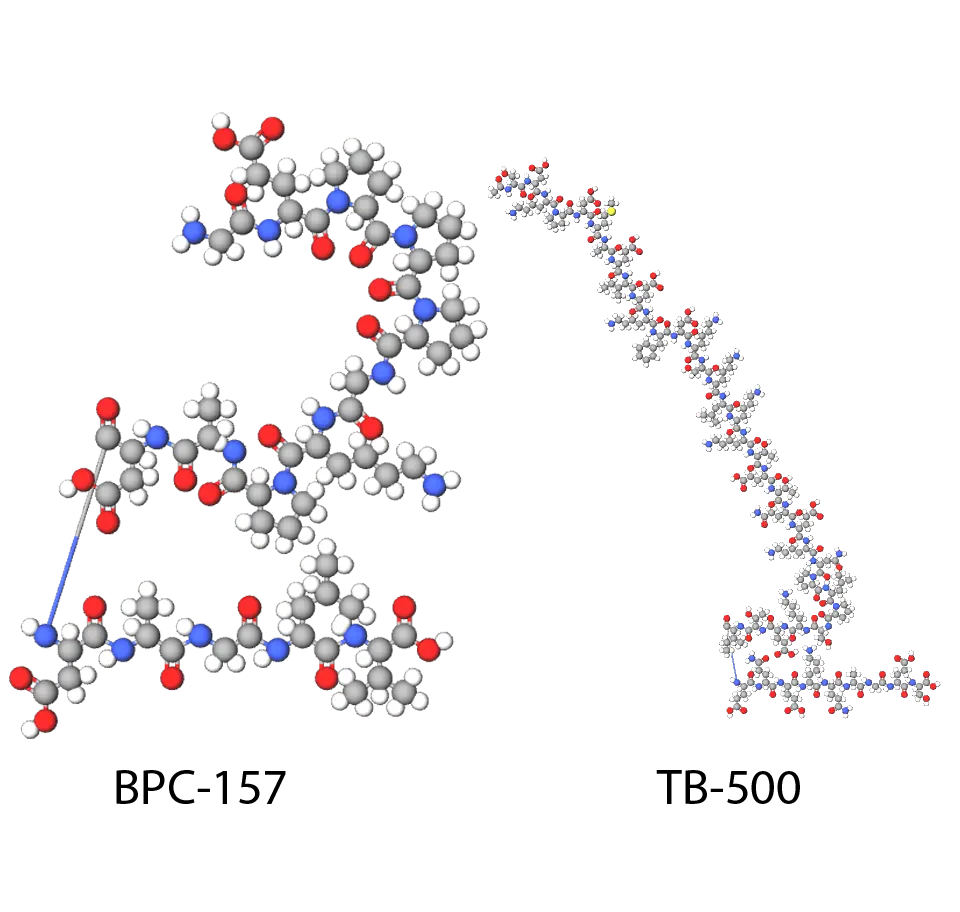
Wolverine (TB-500/BPC-157) is a synthetic peptide blend meticulously prepared for scientific inquiry. This product, combining TB-500 and BPC-157, is synthesized with high purity for laboratory investigations. It is developed for use in various research applications. Wolverine is designated solely for research and development purposes.

TB-500 features a 43-amino-acid sequence (SDKPDMAEIEKFDKSKLKKTETQEKNPLPSKETIEQEKQAGES), with a molecular weight of about 4963 Da, including a central actin-binding motif (LKKTETQ) that confers its functional core. BPC-157, in contrast, is a shorter pentadecapeptide (GEPPPGKPADDAGLV) with a molecular weight around 1419 Da, designed for high stability and resistance to enzymatic breakdown in physiological environments. When combined, these peptides maintain their individual profiles but may exhibit enhanced bioavailability, as TB-500''s actin sequestration complements BPC-157''s proteolytic resistance.
In practical terms, our TB-500/BPC-157 blend is supplied as a lyophilized powder mixture, with each component verified for purity exceeding 98% through HPLC and mass spectrometry. The combination shows excellent solubility in neutral buffers, facilitating reconstitution for cell culture or tissue assays. We prioritize transparency in our testing, ensuring the blend''s stability supports reliable, reproducible experiments without unexpected interactions.
The TB-500/BPC-157 combination unites two potent peptides—TB-500 (thymosin beta-4), a 43-amino-acid actin-binding protein, and BPC-157, a 15-amino-acid fragment derived from gastric juice proteins—each renowned for their regenerative properties in promoting tissue repair, reducing inflammation, and enhancing healing in experimental models. This synergistic blend leverages TB-500''s role in cytoskeletal reorganization and angiogenesis alongside BPC-157''s cytoprotective and angiogenic effects, offering researchers a comprehensive tool for in-vitro studies on wound healing, musculoskeletal recovery, and metabolic adaptation. As with all our peptides, the TB-500/BPC-157 combination is supplied strictly for research purposes and in-vitro use only—not for human consumption or any therapeutic applications.
TB-500 primarily sequesters G-actin to inhibit polymerization, promoting cell migration, angiogenesis via VEGF upregulation, and anti-inflammatory effects by suppressing NF-κB and cytokines like TNF-α. BPC-157, meanwhile, enhances growth hormone receptor expression in fibroblasts, accelerates collagen formation and granulation tissue development, and modulates NO generation through Src/caveolin-1 pathways to support vascular integrity and anti-fibrotic actions via TGF-β inhibition. In combination, these peptides may synergize to amplify tissue regeneration, with TB-500''s cytoskeletal support complementing BPC-157''s cytoprotection, potentially leading to faster wound closure and reduced scarring in models.
This integrated mechanism could involve shared pathways like increased vessel density and reduced proinflammatory cytokines, fostering a balanced healing environment. We''re passionate about these details—consider how the duo offers a multifaceted view of repair processes, and we''re ready to discuss assay designs that highlight their interplay.
In wrapping up, the TB-500/BPC-157 combination represents a dynamic duo for advancing in-vitro understanding of regenerative mechanisms, blending actin regulation and cytoprotection to support comprehensive healing and tissue resilience. Its potential in modeling complex repair processes fuels our shared enthusiasm for peptide research, delivered with the quality and education you deserve. Strictly for research use, this blend highlights our approachable commitment to fostering scientific connections with integrity. Let''s collaborate to uncover more, one steady investigation at a time.
The TB-500/BPC-157 combination is particularly suited for in-vitro research in regenerative medicine, focusing on musculoskeletal, gastrointestinal, and neurological healing. In tendon fibroblast cultures, BPC-157''s promotion of GH receptor expression pairs with TB-500''s actin modulation to enhance collagen synthesis and cell migration, as seen in models of tendon injury recovery. Wound healing assays demonstrate accelerated epithelialization and angiogenesis, with the blend counteracting fibrosis in dermal or myocardial models.
In inflammatory paradigms, such as those simulating ulcerative colitis or ischemia, the combination reduces cytokine levels and supports tissue integrity, potentially extending to neuroprotection in oxidative stress models. Emerging applications include antimicrobial and anti-fibrotic studies, where metabolites like Ac-SDKP from TB-500 align with BPC-157''s pleiotropic effects. We suggest using it in co-culture systems to explore synergies, and our team can provide logical tips for protocol optimization based on evidence.
To maintain the TB-500/BPC-157 combination''s efficacy in your experiments, store the lyophilized powder at -20°C or below in a desiccated, light-protected container. Reconstitute with sterile bacteriostatic water or neutral buffer to 1-2 mg/mL per peptide, gently swirling to dissolve without introducing foam that could denature structures. Prepared solutions are best aliquoted and used fresh, with short-term refrigeration at 2-8°C or freezing for extended storage, avoiding multiple freeze-thaw cycles.
Our stability assessments confirm the blend''s durability, but verify pH and clarity prior to use. If compatibility issues arise with your assays, reach out—we''ll offer calm, rational solutions grounded in best practices.
The TB-500/BPC-157 combination unites two potent peptides—TB-500 (thymosin beta-4), a 43-amino-acid actin-binding protein, and BPC-157, a 15-amino-acid fragment derived from gastric juice proteins—each renowned for their regenerative properties in promoting tissue repair, reducing inflammation, and enhancing healing in experimental models. This synergistic blend leverages TB-500''s role in cytoskeletal reorganization and angiogenesis alongside BPC-157''s cytoprotective and angiogenic effects, offering researchers a comprehensive tool for in-vitro studies on wound healing, musculoskeletal recovery, and metabolic adaptation. As with all our peptides, the TB-500/BPC-157 combination is supplied strictly for research purposes and in-vitro use only—not for human consumption or any therapeutic applications.
TB-500 primarily sequesters G-actin to inhibit polymerization, promoting cell migration, angiogenesis via VEGF upregulation, and anti-inflammatory effects by suppressing NF-κB and cytokines like TNF-α. BPC-157, meanwhile, enhances growth hormone receptor expression in fibroblasts, accelerates collagen formation and granulation tissue development, and modulates NO generation through Src/caveolin-1 pathways to support vascular integrity and anti-fibrotic actions via TGF-β inhibition. In combination, these peptides may synergize to amplify tissue regeneration, with TB-500''s cytoskeletal support complementing BPC-157''s cytoprotection, potentially leading to faster wound closure and reduced scarring in models.
This integrated mechanism could involve shared pathways like increased vessel density and reduced proinflammatory cytokines, fostering a balanced healing environment. We''re passionate about these details—consider how the duo offers a multifaceted view of repair processes, and we''re ready to discuss assay designs that highlight their interplay.
In wrapping up, the TB-500/BPC-157 combination represents a dynamic duo for advancing in-vitro understanding of regenerative mechanisms, blending actin regulation and cytoprotection to support comprehensive healing and tissue resilience. Its potential in modeling complex repair processes fuels our shared enthusiasm for peptide research, delivered with the quality and education you deserve. Strictly for research use, this blend highlights our approachable commitment to fostering scientific connections with integrity. Let''s collaborate to uncover more, one steady investigation at a time.
TB-500 features a 43-amino-acid sequence (SDKPDMAEIEKFDKSKLKKTETQEKNPLPSKETIEQEKQAGES), with a molecular weight of about 4963 Da, including a central actin-binding motif (LKKTETQ) that confers its functional core. BPC-157, in contrast, is a shorter pentadecapeptide (GEPPPGKPADDAGLV) with a molecular weight around 1419 Da, designed for high stability and resistance to enzymatic breakdown in physiological environments. When combined, these peptides maintain their individual profiles but may exhibit enhanced bioavailability, as TB-500''s actin sequestration complements BPC-157''s proteolytic resistance.
In practical terms, our TB-500/BPC-157 blend is supplied as a lyophilized powder mixture, with each component verified for purity exceeding 98% through HPLC and mass spectrometry. The combination shows excellent solubility in neutral buffers, facilitating reconstitution for cell culture or tissue assays. We prioritize transparency in our testing, ensuring the blend''s stability supports reliable, reproducible experiments without unexpected interactions.

The TB-500/BPC-157 combination is particularly suited for in-vitro research in regenerative medicine, focusing on musculoskeletal, gastrointestinal, and neurological healing. In tendon fibroblast cultures, BPC-157''s promotion of GH receptor expression pairs with TB-500''s actin modulation to enhance collagen synthesis and cell migration, as seen in models of tendon injury recovery. Wound healing assays demonstrate accelerated epithelialization and angiogenesis, with the blend counteracting fibrosis in dermal or myocardial models.
In inflammatory paradigms, such as those simulating ulcerative colitis or ischemia, the combination reduces cytokine levels and supports tissue integrity, potentially extending to neuroprotection in oxidative stress models. Emerging applications include antimicrobial and anti-fibrotic studies, where metabolites like Ac-SDKP from TB-500 align with BPC-157''s pleiotropic effects. We suggest using it in co-culture systems to explore synergies, and our team can provide logical tips for protocol optimization based on evidence.
To maintain the TB-500/BPC-157 combination''s efficacy in your experiments, store the lyophilized powder at -20°C or below in a desiccated, light-protected container. Reconstitute with sterile bacteriostatic water or neutral buffer to 1-2 mg/mL per peptide, gently swirling to dissolve without introducing foam that could denature structures. Prepared solutions are best aliquoted and used fresh, with short-term refrigeration at 2-8°C or freezing for extended storage, avoiding multiple freeze-thaw cycles.
Our stability assessments confirm the blend''s durability, but verify pH and clarity prior to use. If compatibility issues arise with your assays, reach out—we''ll offer calm, rational solutions grounded in best practices.
